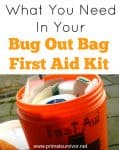
Of all the things I chose for my Bug Out Bag, the items for the first aid kit were the hardest.
Bug Out Bag packing is tricky because you want to make sure that you have every single item you’d need in a SHTF survival situation – but you also want to make sure that the BOB is light enough that you’d be able to flee with it.
In other words, you aren’t packing your entire home first aid kit in your Bug Out Bag!
There is no one “best” way to pack a Bug Out Bag first aid kit. What you choose for your kit is going to vary depending on factors like:
- How many people are in your group
- The health of each person in the group
- Your medical knowledge
- Your knowledge of natural remedies
- Whether you will be going through an urban environment or not
Here is how I built my Bug Out Bag First Aid Kit. Again, I don’t expect you to copy this exactly. Instead, I hope it will help you assess your needs so you can pack the right items.
What Are the Most Likely Injuries That You Will Face When Bugging Out?
We can’t predict what will happen in a SHTF Bug Out situation, but we can look at examples of past disasters to get an idea.
Trauma Injuries
In emergencies such as natural disasters, warfare, terrorist attacks, or mass rioting, you end up with a lot of glass and rubble in the streets. As a result, trauma injuries are very common. Let’s hope you don’t have to deal with a gunshot wound, but this is also possible. See our guide to trauma kits and IFAKs
Burn Injuries
One scenario which particularly scares me is the idea of fire everywhere. Rioters often set fires in the street, and citizens end up with severe burns. Fires can also be widespread in disasters like earthquakes where gas mains break. So, I want to ensure I am prepared to treat burn injuries.
Scrapes and Minor Wounds
There are sure to be a lot of minor injuries when bugging out, but I wouldn’t worry about them too much. What does become a concern is when you’ve got minor cuts and are in unsanitary conditions.
For example, many people had to be hospitalized after Hurricanes Katrina because of skin infections. They got minor cuts which were exposed to the dirty flood water. This led to infections. To prevent this, you’ll need to ensure you’ve got a way to protect and disinfect those small wounds.
Mobility Injuries
Have you ever tried climbing over the rubble of a demolished building or running through streets filled with debris? No matter how careful you are, there is a good chance you could twist your ankle and end up with a bad sprain or torn ligament.
As someone who hikes a lot, I can tell you that these injuries really suck. It will be tough to bug out when you can barely walk! So, your first aid kit must factor in how you’d treat these mobility injuries.
Mobility injuries also include more minor wounds like blisters. I’ve got an extra pair of socks in my Bug Out Bag (read more about the best survival socks) to prevent blisters, but I’m also packing some moleskin in case of blisters. It seems trivial, but a blister can slow you down.
Disease and Infection
No one likes to discuss this aspect of disaster planning, but disasters bring horrible hygiene issues.
You should have an emergency water purification method in your Bug Out Bag, but you don’t have to drink dirty water to be infected. Walking through contaminated water, for example, can lead to infections if it gets into your body through cuts or scrapes.
Likewise, you might touch your mouth or eyes after coming in contact with dirty water. You better be able to treat the diarrhea, vomiting, and fever which could occur!
Shock and Hypothermia are also medical concerns when bugging out. So, make sure your Bug Out Bag first aid kit is packed accordingly.
Personal Medical Needs
This one should be obvious, but your Bug Out Bag first aid kit needs to include any personal medical items you need. Talk to your doctor and ask if you can get “just in case” backups of your medications.
Just be warned that meds can expire quickly – especially if they are in warm, humid places like the trunk of your car (I keep one Bug Out Bag in my car).
Bug Out Bag Survival First Aid Kit
*Item quantities are listed for 2 people. Remember that this is just a guideline to be used for inspiration. Adjust the items and quantities based on your needs!
- 1 Tourniquet – see best tourniquets for your medical kit
- 1 Waterproof pouch
- 2-3 pairs of medical gloves
- 5 8? x10? sterile heavy gauze (combine dressings)
- 3-5 Trauma pads with blood clotting agent
- 1 Roller bandage
- 4-inch butterfly closure strips, suture kit, wound stapler, or another method of closing larger wounds
- 1 Blood clotting agent
- 1 Antiseptic burn salve
- 1 small tube of antibiotic wound ointment
- 4 Alcohol prep pads
- 3-5 Q-tips and cotton balls
- 1 Mylar blanket
- 1 Ace bandage
- 1 Roll of medical tape
- 1 Moleskin pack
- 1 Snake bite kit (depending on where you will be bugging out)
- 2 N95 respirator mask (read about how to choose a respirator mask here)
- 2-5 Oral rehydration salts
- 3 Days’ worth of antidiarrheal medications
- 3 Days’ worth of painkillers (OTC or prescription, depending on what you have access to)
- 2 Courses of Antibiotics (Read this post about fish antibiotics)
- 2 Safety pins or needles
- 1 Multitool with tweezers and scissors
- Personal medications
- EpiPen (For people with allergies; remember that these expire quickly!)
- Potassium iodide (If you live near a nuclear plant, you want this in your BOB kit!)
- Honey packets (Good for people with diabetes or for treating Hypothermia)
What I Did NOT Pack in My Bug Out Bag First Aid Kit
As I said before, packing my Bug Out Bag First Aid Kit was tricky because I wanted to ensure I had enough of each item for the situation but wanted to keep the BOB as light as possible.
So, I left out any items which weren’t absolutely necessary or could be easily replaced with a found item. These include:
- Splint: I could easily make a splint with a branch, so there is no need to put this in the BOB
- Triangle Bandage: While triangle bandages are useful for making a sling or as a broad-fold bandage, you can just use your shirt. I’ve got a bandana in my BOB, so there’s no need for me to include a triangle bandage. Read more about triangle bandages.
- Scissors: I’ve got scissors in my multitool, so I’m not packing special medical scissors.
- Magnifying Glass: This is useful for cleaning wounds and could also be used as an emergency firestarter. However, it is bulky, and the glass could easily break, so I left it out.
- IV Kit: I saw that some preppers recommend packing an IV kit. This only makes sense if you are a trained medical professional. I am not confident using an IV kit, so I won’t bring one.
- Bandaids: When hiking, I just put a piece of medical tape over small wounds to keep out debris. In a Bug Out situation, I’d do the same.
- Wound Irrigation Syringe: I am still not 100% sure of this one. It would be beneficial and possibly life-saving for cleaning wounds, but it also doesn’t seem necessary since I could use water/cotton balls/tweezers to clean wounds. Let me know if you have an opinion on this!
Want to learn more about packing a Bug Out Bag? Read:
Did you build your Bug Out Bag First Aid Kit yet? Let us know in the comments



